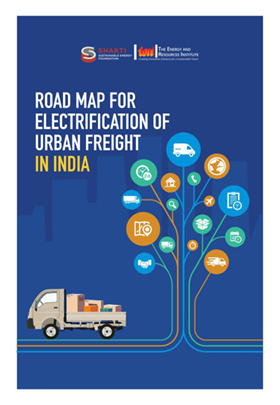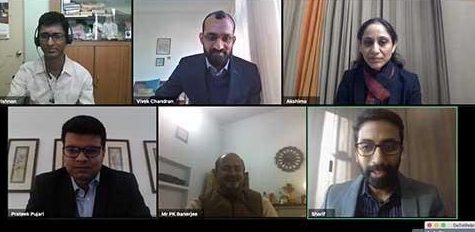Urban freight plays an essential role in the social and economic development of cities. Globally, urban freight represents 10% to 15% of vehicle equivalent miles travelled in city streets and 2–5% of the employed urban workforce. In India, rapid urbanisation is driving the demand for freight transportation. By 2050, over 814 million people will be living in urban areas, which is likely to usher in more commercial activities and movement of goods. This will create a huge demand for urban freight vehicles particularly light/small commercial vehicles.
It is therefore critical to promote low-carbon vehicle technologies to negate the adverse impact of using polluting fuels and their environmental impact. Indian cities are among the top 15 most polluted cities in the world. Urban freight contributes significantly to GHG emissions and air pollution in our cities, particularly from light/small commercial vehicles that ply mainly on diesel. Electric vehicles are emerging as one of the most viable options, apart from being the cleanest form of technology commercially available, with the potential to reap a host of energy security, economic, emissions reduction and public health benefits.
Electrifying Freight: Pathways to Accelerating the Transition
 A report supported by Shakti Sustainable Energy Foundation and authored by The Energy and Resources Institute entitled Roadmap for Electrification of Urban Freight in India, addresses the major barriers impeding the adoption of electric freight vehicles and clearly lays out actions that stakeholders can take to facilitate and accelerate freight electrification.
A report supported by Shakti Sustainable Energy Foundation and authored by The Energy and Resources Institute entitled Roadmap for Electrification of Urban Freight in India, addresses the major barriers impeding the adoption of electric freight vehicles and clearly lays out actions that stakeholders can take to facilitate and accelerate freight electrification.
The report is based on an analysis of five sectors across three cities—Delhi, Bengaluru and Surat. The case studies were conducted to assess techno-economic potential of electrifying freight movement in postal services and third-party logistics (e-commerce) in Bengaluru, textile industry and municipal solid waste collection in Surat, and fruits and vegetables distribution from Agricultural Produce Market Committee (APMC) mandis (wholesale markets) in Delhi.
The highest potential for electrification was identified in Solid Waste Collection in Surat. This was mainly due to high current operational costs, fixed routes for waste collection, ease of setting up charging solutions at transfer stations and fleet level ownership. Overall, total cost of ownership (TCO) analysis demonstrates that the cost economics associated with EVs are quite different between the four-wheeler (4W) and three-wheeler (3W) segments. For 4Ws, the high purchase cost presents the most significant challenge for widespread uptake. For 3-W, the conclusions are much more favourable, with electric vehicles having lower TCO both at net present value and cumulatively.
Key Findings
- Small commercial vehicle (3W) segment is likely to grow at a CAGR of 9% between 2021 and 2031.
- The share of 4W LCV segment is expected to be 76% of the total stock of light commercial vehicles (LCVs) by 2030.
- Majority of the LCVs are run on diesel, followed by CNG and gasoline. However, with the rising diesel prices and lower cost of e3Ws, the total cost of operation is rapidly turning in favour of EV variants.
- The share of BS-IV LCVs is low, indicating the wider use of inefficient vehicles
- EVs are increasingly being introduced in the urban freight/last-mile delivery services in India cities. Several niche organizations are operating on EV to serve their customers
- 14% reduction in CO2 emissions is attainable in the small commercial vehicle segment with higher EV penetration
- Performance of the vehicle is one of the major key concerns of drivers, which included range of the vehicle, the speed and payload carrying capacity
Download the report – Volume I and Volume II
Launch of the Roadmap
 The culminating roadmap was launched at a virtual conference on December 18, 2020 in the presence of stakeholders from the the transport and freight sectors. Speaking at the event, Shri Sudhendu J Sinha, Adviser, Transport, NITI Aayog, highlighted some of the inherent that must be overcome in the transition to clean freight, particularly with respect to the huge financing needs. Currently, India is at an early stage of EV transition, and the freight vehicle segment offers a front-runner advantage. This is why, the conference participants, underscored the importance of sufficient infrastructure and incentives for transforming the freight fleet and the imperative for cooperation among diverse industry and government stakeholders to make these new vehicles commercially competitive for fleet owners.
The culminating roadmap was launched at a virtual conference on December 18, 2020 in the presence of stakeholders from the the transport and freight sectors. Speaking at the event, Shri Sudhendu J Sinha, Adviser, Transport, NITI Aayog, highlighted some of the inherent that must be overcome in the transition to clean freight, particularly with respect to the huge financing needs. Currently, India is at an early stage of EV transition, and the freight vehicle segment offers a front-runner advantage. This is why, the conference participants, underscored the importance of sufficient infrastructure and incentives for transforming the freight fleet and the imperative for cooperation among diverse industry and government stakeholders to make these new vehicles commercially competitive for fleet owners.
